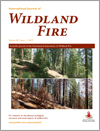
International Journal of Wildland Fire
Volume 28 Number 1 2019
WFv28n1_OBIn Memoriam: Craig Clayton Chandler (22 September 1926–27 September 2017)
WF18107The failure of planning to address the urban interface and intermix fire-hazard problems in the San Francisco Bay Area
Destructive fires burning into cities in 2017 and 2018 call attention to the long history of fires in California. This commentary summarizes this history and the failure to carry out proposals for wildland fuel management following major fires. California is destined to repeat its history of destructive urban interface fires, without the authority and funding to enforce wildland fuel management.
WF18046The role of defensible space on the likelihood of house impact from wildfires in forested landscapes of south eastern Australia
We analysed the influence of defensible space (fuels within 30 m) on 927 houses exposed to 27 wildfires in New South Wales, Australia. Vegetation and other houses in this zone increased and waterbodies within 200 m decreased likelihood of impact. This re-enforces the importance of defensible space for wildfire risk management.
WF18058Factors that affect the timing of the dispatch of initial attack resources to forest fires in northeastern Ontario, Canada
We examined some of the factors that influence fire managers in northeastern Ontario when they dispatch initial attack resources to fires. Our results suggest that their decisions are influenced by the total number of fires reported the day the fire is reported, the time the fire is reported and the fire weather conditions that day.
WF18138Public perceptions towards wildfire preparedness in the Veluwe region of the Netherlands
The highly populated country of The Netherlands is experiencing increasing wildland fire events, most caused by arson and driven by increasingly dangerous conditions arising from changing climate. A public survey performed in the highly visited Veluwe, a large recreational area in the centre of the country, found that respondents believed that wildfires were a threat to natural areas but not to themselves. Increased efforts to educate the public about the wildfire threat may need to be applied to reduce the danger to residents and visitors to this region.
WF18018Predicting wildfire vulnerability using logistic regression and artificial neural networks: a case study in Brazil's Federal District
 , Eraldo Aparecido Trondoli Matricardi, Renato Fontes Guimarães and Roberto Arnaldo Trancoso Gomes
, Eraldo Aparecido Trondoli Matricardi, Renato Fontes Guimarães and Roberto Arnaldo Trancoso Gomes
This study sought to predict wildfire risk areas within a region inside the Brazilian biome known as the Cerrado. To do so, regression and machine-learning models were used in order to predict the probability of fire occurring given a set of environmental variables related to the occurrence of fire.
WF18031Multi-scale assessment of post-fire tree mortality models
We conducted an evaluation of post-fire tree mortality models with the largest sample to date, and we summarised model accuracy at multiple scales. We found that First Order Fire Effects Models generally had high accuracy for gymnosperms, but accuracy was poor for angiosperms. Fire-related mortality was elevated because of severe multi-year drought, and we provide new mortality models with improved accuracy for fires that occur during drought.
WF18031 Abstract | WF18031 Full Text | WF18031PDF (1.3 MB) | WF18031Supplementary Material (1.2 MB) Open Access Article
Our research firmly establishes Arizona cypress as a fire-sensitive but fire-embracing tree species dependent on stand-replacing fires for regeneration. Given its fire sensitivity, however, recent increases in fire frequency in the south-west USA could threaten the viability of this species by preventing the tree from reaching maturity between fires.
WF18048Fuel dynamics during oak woodland and savanna restoration in the Mid-South USA
 , Patrick D. Keyser, Charles Kwit, Michael C. Stambaugh, Wayne K. Clatterbuck and Dean M. Simon
, Patrick D. Keyser, Charles Kwit, Michael C. Stambaugh, Wayne K. Clatterbuck and Dean M. Simon
We monitored fuel loads during oak woodland and savanna restoration in the Mid-South. Large (≥2.54 cm in diameter) woody fuels increased with increasing thinning intensity, and subsequent burning often failed to reduce this addition. Burning and thinning resulted in a net reduction in smaller fuels: increases in herbaceous fuels did not offset decreases in twigs and leaf litter.



